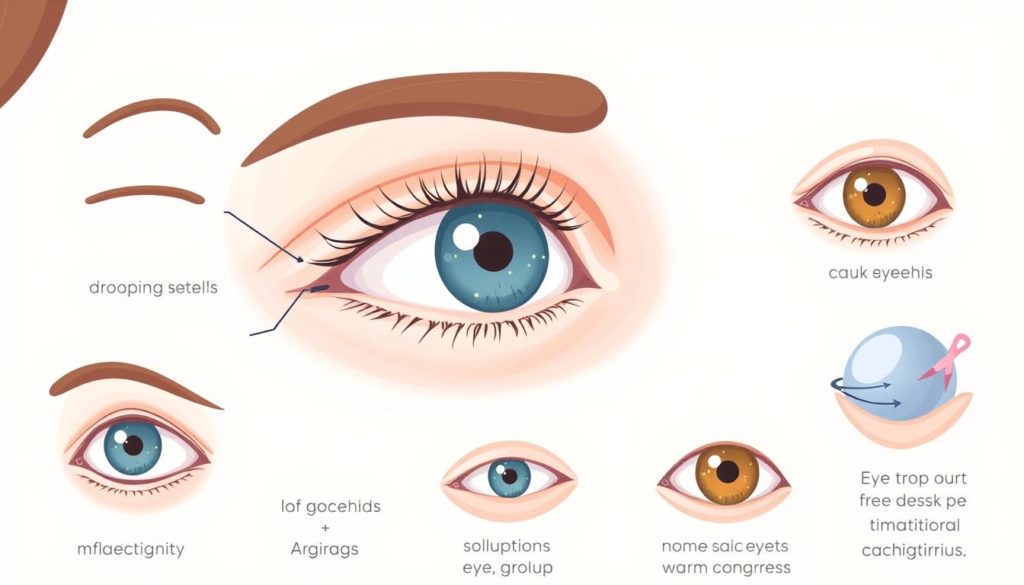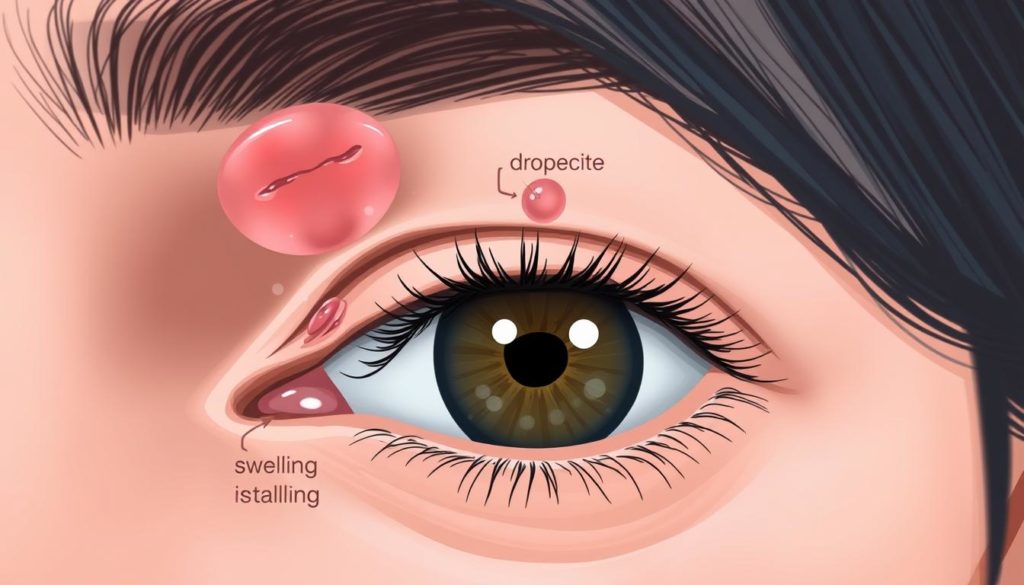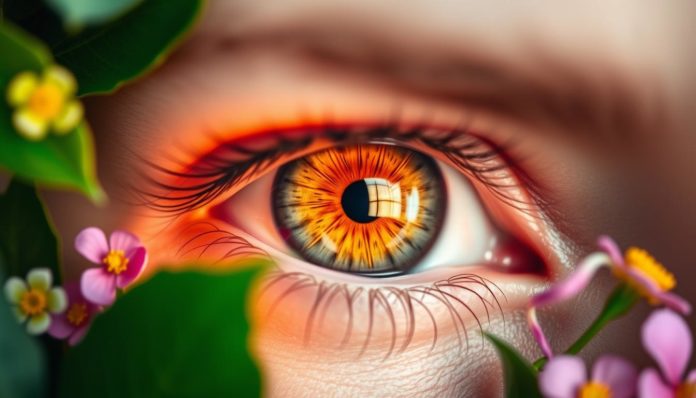Did you know nearly 25% of those over 50 have droopy eyelids or other issues? While seen as minor, these problems can greatly affect eye health and well-being.
Eyelid asymmetry might point to conditions like thyroid issues. It’s important to take care of your eyes early on. Dealing with these issues may involve makeup, medicines, or surgery like blepharoplasty. It’s vital to find the right fix.
Genetics and lifestyle, such as stress, can affect your eyelids. Luckily, there are many treatments available. These range from warm compresses and meds to injections and surgery. Knowing your specific issue is the first step to treatment.
We’ll explore the causes, symptoms, and solutions for eyelid problems. Our goal is to help you keep your eyes healthy.
Introduction to Eyelid Disorders
Eyelids protect our eyes from foreign objects and help keep them moist. Good eye and eyelid health is key for clear vision and overall wellness. We will explore the importance of this and the symptoms that may show early signs of a problem.
Importance of Eye and Eyelid Health
The role of healthy eyelids is huge. They guard our eyes against dirt and spread tears evenly to prevent dry eyes and infections. Knowing the causes and treatments of eyelid issues is critical. This knowledge helps us manage and avoid further problems.

Common Symptoms and Initial Signs
Spotting the early signs of an eye ailment is crucial for timely help. Early signs can be eyelids drooping, twitching, swelling, or blinking oddly. These signs could point to serious health issues needing a doctor’s care. Knowing these symptoms aids in quick diagnosis and treatment, keeping our eyes healthy.
| Symptom | Potential Condition |
|---|---|
| Drooping Eyelid | Ptosis |
| Twitching Eyelid | Blepharospasm |
| Inflammation | Blepharitis |
| Abnormal Blinking | Nerve Disorders |
Common Causes of Eyelid Problems
Eyelid disorders come from many places, like infections, genes, and the environment around us. Knowing what causes each disorder helps us treat them better.

Blepharitis causes often link to bacterial infections or oil gland issues near the eyelashes. If you don’t keep your eyelids clean, or if dust and smoke get in your eyes, it can make things worse.
Chalazion causes usually start with blocked oil glands in the eyelids. This leads to a lump, which might get inflamed or infected. Stress and changes in hormones can make it more likely to happen.
Ptosis causes can be from muscles getting weaker with age, an injury, or nerve problems. Using contact lenses a lot can also make eyelids droop over time.
Inflammation in the eye can come from many irritants and certain diseases. Allergies, blepharitis, and conjunctivitis can make your eyelids inflamed. This can be painful and make it hard to see.
- Stye Triggers: Styes come from bacterial infections at the eyelash base. These infections cause red, painful bumps filled with pus.
- Xanthelasma Factors: Yellowish deposits around the eyelids can signal cholesterol problems. Genetics and certain metabolic issues also have a role.
| Condition | Main Causes |
|---|---|
| Blepharitis | Bacterial infections, oil gland dysfunction, irritants |
| Chalazion | Blocked oil glands, stress, hormonal changes |
| Ptosis | Muscle weakening, trauma, neurological disorders, repetitive motion |
| Eye Inflammation | Allergies, blepharitis, conjunctivitis, autoimmune diseases |
| Styes | Bacterial infections at the base of eyelashes |
| Xanthelasma | Cholesterol imbalances, genetics, metabolic conditions |
Blepharitis: Symptoms and Treatments
Blepharitis is a common eye condition with symptoms like redness, itching, swelling, and crusting of the eyelids. It’s important to treat these symptoms early for eye health. This condition may be caused by bacteria or issues like rosacea.
To manage this condition, keep your eyes clean. Regular eyelid cleaning reduces inflammation. Here are effective steps against blepharitis:
- Apply warm compresses to ease eyelid swelling and remove crusts.
- Use antibiotic ointments to fight bacteria and avoid infection.
- If it’s serious, steroid eye drops might be needed but under supervision to handle inflammation.
Using these treatments helps, but fixing any underlying skin issues like rosacea matters for lasting relief. If blepharitis keeps up, seeing an eye doctor is crucial. They will help find the right eye inflammation solutions and eyelid redness remedy just for you.
Ptosis: Understanding Droopy Eyelids
Ptosis, or droopy eyelids, affects people of all ages. It’s more than just a cosmetic issue; it can also block vision. Knowing why ptosis happens and the treatments available is key.
Causes of Ptosis
Many reasons can cause ptosis. Key ptosis causes include:
- Age-related eyelid changes: Eyelid muscles may weaken with age, leading to droopiness.
- Congenital factors: Some are born with ptosis due to muscle development problems.
- Nerve and muscle diseases: Illnesses like myasthenia gravis can cause muscle weakness, resulting in ptosis.
Treatment Options for Ptosis
There are various ways to manage and fix ptosis, depending on the cause:
- Non-Surgical Treatments: For mild cases, exercises for the eyelids and special glasses might help.
- Ptosis surgery: More serious cases, especially those affecting vision, might need surgery to correct the droopiness.
Dealing with Eyelid Twitching: Blepharospasm
Eyelid twitching often happens due to stress or being tired. But if it keeps up, it might be a sign of blepharospasm. This problem starts in a part of the brain called the basal ganglion.
What Causes Eyelid Twitching?
Many things can set off eyelid twitching. These include too much stress, not enough sleep, drinking a lot of caffeine, and eye strain. If it gets worse, it may turn into blepharospasm. This causes uncontrollable eye muscle contractions, making you really uncomfortable.
Treatment Methods for Blepharospasm
There are good treatments for blepharospasm. A common one involves injections with botulinum toxin to calm the eye spasms. Eye experts do these injections. They help lessen the muscle contractions, giving relief for months.
In tough cases, myectomy surgery might be the answer. This operation takes out some eye muscles and nerves to reduce twitching. It’s more intense but can help a lot with ongoing blepharospasm.
| Treatment Method | Pros | Cons | Suitable For |
|---|---|---|---|
| Botulinum Toxin Injections |
|
|
|
| Myectomy Surgery |
|
|
|
Solutions for Eyelid Inflammation
Eyelid inflammation can cause discomfort, but understanding its causes helps treat it. Common reasons include infections, blocked glands, and allergies. There are several ways to ease the symptoms and feel better:
Warm compresses can unblock glands on your eyelids. This brings quick relief. Keeping your eyelids clean is very important. Use a gentle soap or a special eyelid scrub to avoid more irritation and help healing.
If infections are causing the problem, doctor-prescribed treatments may be needed. Antibiotic or steroid eye drops can fight redness and pain. They also lower swelling and inflammation. For allergies, antihistamine eye drops or pills can help a lot.
- Warm Compresses: Use them for 5-10 minutes a few times daily to ease discomfort.
- Hygiene Practices: Clean your eyelids with a mild cleaner or special scrub to stop more inflammation.
- Medications: Use medicines as the doctor orders to fight infections.
- Antihistamines: For allergies causing inflammation, think about using antihistamine options.
Following these steps can help manage eyelid inflammation well. Always take care of your eyelids and talk to an eye specialist for the best advice. Keeping up with care is key to reducing problems and staying comfortable.
Understanding Chalazion and its Treatments
A chalazion is a common eyelid problem. It happens when an oil gland gets blocked. This leads to a bump that can be both uncomfortable and look bad. Knowing what causes it and how to treat it is key.
Causes of Chalazion
Chalazions start when an oil gland in the eyelid gets blocked. The meibomian gland, specifically, gets clogged and forms a lump. Though usually painless, it can sometimes get swollen, red, and sore.
Treatment Options Available
There are several ways to treat an eyelid bump, like a chalazion. Let’s look at some common ones:
- Warm compresses: Putting a warm compress on the area many times a day can melt the clogged oil. This reduces the bump.
- Antibiotic eye drops or ointments: If there’s an infection or a lot of swelling, doctors may suggest antibiotics.
- Surgical removal: If the chalazion doesn’t get better with other treatments, chalazion surgery may be needed to fix the problem.
| Treatment Method | Description | Effectiveness |
|---|---|---|
| Warm Compresses | Uses heat to dissolve the blockage | High for mild cases |
| Antibiotic Treatments | Eye drops or ointments to reduce infection | Moderate for infected or inflamed chalazion |
| Chalazion Surgery | Minor procedure to drain the bump | Highly effective for persistent cases |
Eyelid Problems Causes and Solutions
It’s important to know why eyelid problems happen for proper eye care. Issues such as blepharitis, ptosis, and other long-lasting eyelid problems need a detailed plan for treatment.
Addressing eye symptoms quickly is essential. Good cleanliness and regular eye exams can stop many common issues. For long-term conditions, less severe treatments like warm compresses or medicated eye drops are first choices before surgery.
We’re giving a summary of solutions for different eyelid problems here:
| Condition | Causes | Solutions |
|---|---|---|
| Blepharitis | Inflammation, bacterial infection | Warm compresses, antibiotics |
| Ptosis | Muscle weakness, nerve damage | Eye exercises, surgery |
| Chalazion | Blocked oil gland | Warm compresses, minor surgery |
Taking action early with comprehensive eye care is effective in managing these issues, leading to better eye health over time. Always talk to a healthcare expert to find out the best treatment for your condition.
Surgical Options for Eyelid Disorders
Surgery can often fix eye disorders that impact vision or daily living. Each procedure is different, depending on what’s wrong. These options help people understand when surgery is needed and can make life better.
Types of Eyelid Surgeries
There are many kinds of eyelid surgeries. They are made to treat various eye problems. Here are the most common ones:
- Blepharoplasty: This surgery takes away extra skin, muscle, and sometimes fat from eyelids. It makes vision better and gives a younger look.
- Ptosis Repair: It fixes the muscle that lifts the eyelid. This solves the issue of droopy eyelids that block vision.
- Entropion and Ectropion Repair: These surgeries fix eyelids that turn in or out. Without treatment, these conditions can cause discomfort and other issues.
When to Consider Surgery
Knowing when to get eye surgery depends on how severe the eyelid issue is. People think about surgery if:
- The problem with the eyelid is getting in the way of seeing, which makes daily tasks hard.
- When treatments that don’t involve surgery aren’t helping after some time.
- If the issue causes discomfort, keeps getting infected, or leads to more problems.
- When someone feels less confident because of the way their eyelids look due to aging or an injury.
Talking to a doctor for specific advice and looking at surgery choices can improve results. This also helps with eye health.
Ectropion: Causes and Solutions
Ectropion means the lower eyelid turns outward. This leads to dryness, irritation, and sensitivity to light. It often happens due to muscle weakness, facial paralysis, or injuries. Aging also plays a big role, making the eyelid malposition more likely. This exposes the inner eyelid, usually needing a doctor’s care.
For those facing ectropion, there are ways to treat it. Mild cases get better with eye drops or ointments. But, severe cases might need surgery. These surgeries for sagging eyelid correction focus on tightening eyelid muscles. This helps the eyelid work better and stops other eye problems.
It’s crucial to know why ectropion happens and how to fix it. Choosing the right treatment can make life much better. It reduces discomfort and protects the eye from harm.
Entropion and Effective Treatments
Entropion is when the eyelid folds inward. This makes eyelashes scratch the cornea, causing significant eye irritation. If not addressed, the problem can worsen. Knowing the causes and treatment methods is key.
Causes of Entropion
Several factors lead to entropion. Age can relax eye muscles, while scars from trauma or surgeries might contribute. Genetics play a role too. Sometimes, ongoing eye infections or inflammation cause it. Recognizing these causes helps find the right treatment.
Treatment Options
Treatments depend on the severity of entropion. Some use tape to temporarily fix the eyelid’s position. Others use drops or ointments to lessen irritation. But, surgical methods are often needed for a long-term solution to align the eyelid correctly.
Maintaining Good Eyelid Hygiene
Keeping your eyelids clean is key to stopping eyelid problems and keeping your eyes healthy. It’s important to wash the area around your eyes regularly. This helps avoid infections. You should use a gentle cleanser and focus on getting rid of dirt and makeup.
Also, try to use products that are less likely to irritate your skin. Choosing things that are good for sensitive skin can help. This way, you’ll lower the chance of irritation.
It’s also smart to keep your hands off your face and eyes if they’re not clean. This small step can greatly cut down infection risks. Make sure to use a fresh towel every time you wash your face. By doing these things, you can keep your eyelids clean and working well.
Be careful when picking out makeup for your eyes, too. Always go for quality items that eye doctors have checked. And don’t forget to get new ones often to avoid germs. If your eyelids keep bothering you, getting help from a doctor is very important. Acting fast and taking good care of your eyelids is crucial for their health.
FAQ
What are common causes of eyelid problems?
Eyelid problems come from many sources. They can be due to infections or blocked oil glands. They can also stem from autoimmune diseases, genetics, or environmental factors. Aging and habits like frequent contact lens wear also play roles.
What are the initial signs of eyelid disorders?
Early signs include eyelids drooping, twitching, or swelling. You might also blink in odd ways. Spotting these early can help avoid bigger health issues later.
How can blepharitis be treated?
To treat blepharitis, start with keeping the eyelids clean using warm compresses. You might need antibiotic ointments or steroid eye drops too. It’s also key to tackle any root causes for lasting relief.
What are the causes and solutions for ptosis (droopy eyelids)?
Ptosis happens when the eyelid muscles weaken over time. It might be due to aging, birth factors, or nerve issues. Sometimes, non-surgical ways can help for a while. Yet, surgeries like blepharoplasty are often the best fix.
What causes eyelid twitching and how is it treated?
Stress or lack of sleep can make your eyelid twitch. But if it gets serious, it might be a sign of brain issues. Then, treatments could include botulinum toxin shots or even surgery.
How can eyelid inflammation be managed?
If your eyelids are inflamed, it’s important to treat the cause. This might mean dealing with infections or allergies. Keeping your eyelids clean and using prescribed meds can really help.
What is a chalazion and how can it be treated?
A chalazion happens when an oil gland gets blocked, leading to a swollen eyelid. Warm compresses and antibiotic eye drops usually help. Sometimes, doctors need to remove it surgically. Acting quickly can stop worse issues.
When should eyelid surgery be considered?
Surgery is an option when eyelid issues affect your sight or other treatments don’t work. It can fix many long-term problems.
What is ectropion and how is it treated?
Ectropion is when the lower eyelid flip outs, causing irritation. Using artificial tears or protective shields can manage it. Surgery might be needed to fix the eyelid position.
What are the treatments for entropion?
Entropion makes the eyelid fold inward, which is uncomfortable and can harm the cornea. Taping the eyelid or using lubricants offers some relief. Surgery is the best long-term answer.
How important is eyelid hygiene and what practices should be followed?
Keeping your eyelids clean is crucial to avoid problems. Make sure to gently clean around your eyes. Steer clear of irritants, choose your eye makeup wisely, and get medical help if issues don’t improve.


